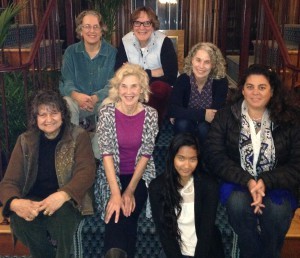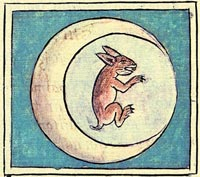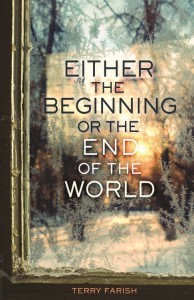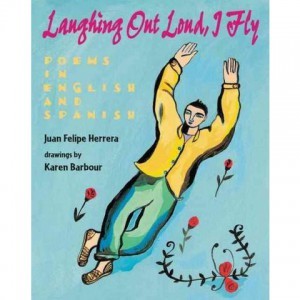Terry Farish's Blog, page 21
October 22, 2015
May You See the Rabbit in the Moon and know it’s the Beginning of the World
 This photo captures an event that happened on a fall night in Kittery, Maine. It has already become one of my all-time favorite events. The people gathered with me are my neighbors who came to hear me read from Either the Beginning or the End of the World at the Rice Library. I met a family for the first time, and they had adopted their Cambodian daughter. Now their daughter is a young woman and she wants to study nursing and help her countrymen. I had brought tiny rabbit-in-the-moon charms that relate to the quest of Sofie in my novel to see the rabbit when she looks up at the moon. When she was a young child, her Cambodian mom
This photo captures an event that happened on a fall night in Kittery, Maine. It has already become one of my all-time favorite events. The people gathered with me are my neighbors who came to hear me read from Either the Beginning or the End of the World at the Rice Library. I met a family for the first time, and they had adopted their Cambodian daughter. Now their daughter is a young woman and she wants to study nursing and help her countrymen. I had brought tiny rabbit-in-the-moon charms that relate to the quest of Sofie in my novel to see the rabbit when she looks up at the moon. When she was a young child, her Cambodian mom  told her look, look, see the rabbit in the moon! I was glad I had the charm to give the young woman from Cambodia and enough for us all. The charm also relates to a Cambodian folk tale in which the rabbit represents immortality. So we all left with our small rabbit in the moon charms, and I had a better sense that this is the beginning of the world.
told her look, look, see the rabbit in the moon! I was glad I had the charm to give the young woman from Cambodia and enough for us all. The charm also relates to a Cambodian folk tale in which the rabbit represents immortality. So we all left with our small rabbit in the moon charms, and I had a better sense that this is the beginning of the world.
May You See the Rabbit in the Moon
 This photo captures an event that happened on a fall night in Kittery, Maine. It has already become one of my all-time favorite events. The people gathered with me are my neighbors who came to hear me read from Either the Beginning or the End of the World at the Rice Library. I met a family for the first time, and they had adopted their Cambodian daughter. Now their daughter is a young woman and she wants to study nursing and help her countrymen. I had brought tiny rabbit-in-the-moon charms that relate to the quest of Sofie in my novel to see the rabbit when she looks up at the moon. When she was a young child, her Cambodian mom
This photo captures an event that happened on a fall night in Kittery, Maine. It has already become one of my all-time favorite events. The people gathered with me are my neighbors who came to hear me read from Either the Beginning or the End of the World at the Rice Library. I met a family for the first time, and they had adopted their Cambodian daughter. Now their daughter is a young woman and she wants to study nursing and help her countrymen. I had brought tiny rabbit-in-the-moon charms that relate to the quest of Sofie in my novel to see the rabbit when she looks up at the moon. When she was a young child, her Cambodian mom  told her look, look, see the rabbit in the moon! I was glad I had the charm to give the young woman from Cambodia and enough for us all. The charm also relates to a Cambodian folk tale So we all left with our small rabbit in the moon charms, and I had a better sense that this is the beginning of the world.
told her look, look, see the rabbit in the moon! I was glad I had the charm to give the young woman from Cambodia and enough for us all. The charm also relates to a Cambodian folk tale So we all left with our small rabbit in the moon charms, and I had a better sense that this is the beginning of the world.
September 27, 2015
A Poem from Juan Felipe Herrera “I went to the marketplace & I bought beautifuls/”
New U.S. Poet Laureate Juan Felipe Herrera, son of migrant workers, writes often about his child self and writes poems for children and teens. In his preface to Laughing Out Loud, I Fly, he writes that when he was seventeen years old he discovered Picasso’s book of poems, Hunk of Skin and says he was “bathed in sunlight.” He said he was inspired by “Picasso’s love of seeing and hearing things differently.” And he sat at this brother-in-law’s table in San Jose and wrote this book. Here are a few lines from “Went to the Marketplace & I Bought Beautifuls”
“I went to the marketplace & I bought beautifuls/ a swollen street pear, a starry nail/on this side of the corner, milk and slippery bread/and the afternoon light…”
He speaks for children growing up in two cultures through the creation of his characters in his picture books, novels and poems. And he takes great joy in sharing Mexican culture and the Spanish language, mixing cultures all up.
As poet laureate, Herrera has invited everybody – all of us, all our ages – to contribute to an epic poem about the American experience as part of his poetry project, La Casa De Colores. The house of colors, he says, is “a house for all voices.”
Published by The Pirate Tree, Social Justice and Children’s Literature.
A Poem from Juan Felipe Herrera
New U.S. Poet Laureate Juan Felipe Herrera, son of migrant workers, writes often about his child self and write poems for children and teens. In his preface to Laughing Out Loud, I Fly, he writes that when he was seventeen years old he discovered Picasso’s book of poems, Hunk of Skin and says he was “bathed in sunlight.” He said he was inspired by “Picasso’s love of seeing and hearing things differently.” And he sat at this brother-in-law’s table in San Jose and wrote this book. Here are a few lines from “Went to the Marketplace & I Bought Beautifuls”
“I went to the marketplace & I bought beautifuls/ a swollen street pear, a starry nail/on this side of the corner, milk and slippery bread/and the afternoon light…”
He speaks for children growing up in two cultures through the creation of his characters in his picture books, novels and poems. And he takes great joy in sharing Mexican culture and the Spanish language, mixing cultures all up.
As poet laureate, Herrera has invited everybody – all of us, all our ages – to contribute to an epic poem about the American experience as part of his poetry project, La Casa De Colores. The house of colors, he says, is “a house for all voices.”
The Kirsten Lee travels with the Blood Moon
 This is a bittersweet fishing story. This morning as I write, fisherman Mike Pawluk is steaming toward Montauk on the Kirsten Lee, a boat he went ground fishing on for about fourteen years. He fished with Captain Steve Lee and they were friends and still are. They’d been through changing fishing regulations together, documenting days at sea, to the quotas and catch share plans. Shrimping closed a few years ago. Mike says the fish weren’t there. The Gulf of Maine was warming. And it was hard not to pull up cod which is restricted. Long long story short. The Kirsten Lee is sold to people on Long Island. Mike was my technical expert on all things fishing as I wrote the story of Johnny, a NH fisherman, and Sofie, his daughter in my novel that comes out this week, Either the Beginning or the End of the World. He told me so many things about the moon and he’ll do this journey on the day of the super moon when it will be enormous and red. The sweet part: Mike got his own boat, a small boat, and he’s had the best season lobstering in his years of fishing.
This is a bittersweet fishing story. This morning as I write, fisherman Mike Pawluk is steaming toward Montauk on the Kirsten Lee, a boat he went ground fishing on for about fourteen years. He fished with Captain Steve Lee and they were friends and still are. They’d been through changing fishing regulations together, documenting days at sea, to the quotas and catch share plans. Shrimping closed a few years ago. Mike says the fish weren’t there. The Gulf of Maine was warming. And it was hard not to pull up cod which is restricted. Long long story short. The Kirsten Lee is sold to people on Long Island. Mike was my technical expert on all things fishing as I wrote the story of Johnny, a NH fisherman, and Sofie, his daughter in my novel that comes out this week, Either the Beginning or the End of the World. He told me so many things about the moon and he’ll do this journey on the day of the super moon when it will be enormous and red. The sweet part: Mike got his own boat, a small boat, and he’s had the best season lobstering in his years of fishing.
Here’s an interview Tammi Truax and I did with Mike for WSCA Radio’s “Seacoast Journal”
One day when Mike and a crewman were fishing on the Kirsten Lee 40 miles off Chincoteague. The crewman became sick and had to be airlifted by a Coast Guard helicopter from the boat. Here’s a picture of the Kirsten Lee from above taken by the rescue team in the helicopter.
http://fisherynation.com/wp-content/uploads/2014/05/kirsten-lee-e1400384988595.jpg
You can hear their voices: My daughter, Elizabeth Farish, collected oral histories of New Hampshire fishermen when she was Regional Site Manager for Historic New England, based in Portsmouth. You can hear them.
September 10, 2015
Dal Mukarung remembers Bhutan
 I saw Dal Rai yesterday. He is the illustrator of the Bhutanese folktale published by the New Hampshire Humanities Council, The Story of a Pumpkin. Like many Bhutanese families who moved to Laconia, New Hampshire, Dal’s family is leaving this small lake district city. He’s pictured here with his sons, Adrin and Anmal, his wife Birkha. and his father, Harka. Harka told me he was born in Bhutan in 1943. Dal was 8 when the Bhutanese government forced his family into exile and took possession of their farm. The Story of a Pumpkin, told in Laconia by Hari Tiwari, is a tale that traveled from Bhutan to the refugee camp in Nepal where Dal and Hari lived for some 20 years to New Hampshire and now on to Ohio where many Bhutanese people live and where Dal seeks to make a home. Dal was an ambassador for the bilingual Nepali-English book to many New Hampshire schools. His work is a gift to children. Good luck, Dal!
I saw Dal Rai yesterday. He is the illustrator of the Bhutanese folktale published by the New Hampshire Humanities Council, The Story of a Pumpkin. Like many Bhutanese families who moved to Laconia, New Hampshire, Dal’s family is leaving this small lake district city. He’s pictured here with his sons, Adrin and Anmal, his wife Birkha. and his father, Harka. Harka told me he was born in Bhutan in 1943. Dal was 8 when the Bhutanese government forced his family into exile and took possession of their farm. The Story of a Pumpkin, told in Laconia by Hari Tiwari, is a tale that traveled from Bhutan to the refugee camp in Nepal where Dal and Hari lived for some 20 years to New Hampshire and now on to Ohio where many Bhutanese people live and where Dal seeks to make a home. Dal was an ambassador for the bilingual Nepali-English book to many New Hampshire schools. His work is a gift to children. Good luck, Dal!
Illustrator Dal Mukarung (Rai) , Good luck in Ohio
 I saw Dal Rai yesterday. He is the illustrator of the Bhutanese folktale published by the New Hampshire Humanities Council, The Story of a Pumpkin. Like many Bhutanese families who moved to Laconia, New Hampshire, Dal’s family is leaving this small lake district city. He’s pictured here with his sons, Adrin and Anmal, his wife Birkha. and his father, Harka. Harka told me he was born in Bhutan in 1943. Dal was 8 when the Bhutanese government forced his family into exile and took possession of their farm. The Story of a Pumpkin, told in Laconia by Hari Tiwari, is a tale that traveled from Bhutan to the refugee camp in Nepal where Dal and Hari lived for some 20 years to New Hampshire and now on to Ohio where many Bhutanese people live and where Dal seeks to make a home. Dal was an ambassador for the bilingual Nepali-English book to many New Hampshire schools. His work is a gift to children. Good luck, Dal!
I saw Dal Rai yesterday. He is the illustrator of the Bhutanese folktale published by the New Hampshire Humanities Council, The Story of a Pumpkin. Like many Bhutanese families who moved to Laconia, New Hampshire, Dal’s family is leaving this small lake district city. He’s pictured here with his sons, Adrin and Anmal, his wife Birkha. and his father, Harka. Harka told me he was born in Bhutan in 1943. Dal was 8 when the Bhutanese government forced his family into exile and took possession of their farm. The Story of a Pumpkin, told in Laconia by Hari Tiwari, is a tale that traveled from Bhutan to the refugee camp in Nepal where Dal and Hari lived for some 20 years to New Hampshire and now on to Ohio where many Bhutanese people live and where Dal seeks to make a home. Dal was an ambassador for the bilingual Nepali-English book to many New Hampshire schools. His work is a gift to children. Good luck, Dal!
August 23, 2015
A Student Speaks for “all the Violas of the world”

Prof. Cathy Eaton, me, and a few of her former Intro to Literature students. They’re also writers themselves.
Students and teachers have shared with me some of the essays written in response to reading The Good Braider. One student, Steven Kidder, wrote an essay about PTSD. It was both well researched and also deeply personal, and his personal response added power to the facts about PTSD. In Viola he saw a person experiencing flashbacks to terror during the war in Juba in the same way his brother-in-law experienced flashbacks. His brother-in-law had returned home from two tours in Afghanistan. Steven writes that his brother-in-law “avoids large crowds of people, because it causes him to feel anxious and uncomfortable. He immediately feels he is at risk in those situations, so he avoids them at all costs. This occurs for Viola when Jamal runs off and is picked up by a couple of men. As opposed to thinking that they are going to simply return him she thinks they are going to attack her like the soldiers did…Even after she recognizes one of them as her classmate Andrew, she can’t escape that feeling of impending terror …” Steven wrote the essay for Cathy’s Eaton’s Introduction to Literature class. Prof. Eaton’s assignments seem to honor both her students’ life experiences (she explains that a number of her students are veterans themselves) and their diversity of cultures. Steven taught me new facets of the struggle with PTSD. He ends his essay with a call to action: “Though there are preliminary studies being done to see the effectiveness of interpersonal psychotherapy and mindfulness in coping with PTSD, there’s still a lot of work to do. We must work together to make sure these stories are heard and that all the Violas in the world know that they and their stories are very important.” Thank you, Steven.
June 22, 2015
Tiger Lily from the ESL Institute, UNH
 Students at the ESL Institute at the University of New Hampshire presented a conference on June 19 to recognize World Refugee Day. ESL Lecturer Meaghan Dunn and her students had read The Good Braider and invited me to come and speak. I did, and went early to see the students’ poster presentations. They each focused on a refugee group and told the story in images and words. Some told of refugees coming to their home country. Students from Indonesia reported the news-breaking story of Rohingya refugees from Myanmar that
Students at the ESL Institute at the University of New Hampshire presented a conference on June 19 to recognize World Refugee Day. ESL Lecturer Meaghan Dunn and her students had read The Good Braider and invited me to come and speak. I did, and went early to see the students’ poster presentations. They each focused on a refugee group and told the story in images and words. Some told of refugees coming to their home country. Students from Indonesia reported the news-breaking story of Rohingya refugees from Myanmar that
 have been given haven in Indonesia. Other students spoke about their own countries where people have been forced to escape. A young woman from Iraq said she is here on a student visa. She hopes at the end of her education, she can return to her home. I wish all the world could have heard these students speak.
have been given haven in Indonesia. Other students spoke about their own countries where people have been forced to escape. A young woman from Iraq said she is here on a student visa. She hopes at the end of her education, she can return to her home. I wish all the world could have heard these students speak.
After I spoke about the courage of a girl from Sudan, two students brought me an armful of flowers. The stunning center flower was a tiger lily. I found this about tiger lilies. “An Asian legend says a hermit once assisted a tiger by removing an arrow from its injured body, giving rise to a belief the tiger lily is symbolic of friendship.” Thank you, all the students and teachers at the ESL Institute. I was your student.
June 17, 2015
Ode to SALT
I j ust pulled out one of Pam Wood’s SALT magazine issues (Dec. 1988) and there is “Monica,” the stunning photo essay by Pam Berry. This essay took my breath when I first read it and does today on the day I hear SALT is closing. Monica is pictured on the cover of the issue. She’s pregnant, her hands dusted in flour cross above her belly. Her head is angled down, the photo ending just above her downcast eyes. SALT does not crop. Anyone at SALT would tell you. So we know the photographer framed the image of Monica in this dramatic way. I was always drawn to the documentary photography of SALT. But what took me to SALT were the first issues Pam Wood created with high school students in Cape Porpoise, Maine. I loved these stories. Pam was training these young writers to document the lives of fishermen in their town but she did it in a way that their work was more than documentation. Pam taught them how to tell stories about real people, how to capture their humor, how to let the reader see how to stitch a bait bag. I loved these articles and when I was writing a novel about a fisherman and his daughter, I found some of the SALT magazines and they gave me the jargon, the gear, the language. Later SALT become the Institute for Documentary Studies and moved to Portland. Pam and her staff then ran semester-long programs for college students. Pam ran an article written by one of her students about fishing years after the Cape Porpoise days, fishing while fisherman chaffed under tight “Days at Sea” regulations.
ust pulled out one of Pam Wood’s SALT magazine issues (Dec. 1988) and there is “Monica,” the stunning photo essay by Pam Berry. This essay took my breath when I first read it and does today on the day I hear SALT is closing. Monica is pictured on the cover of the issue. She’s pregnant, her hands dusted in flour cross above her belly. Her head is angled down, the photo ending just above her downcast eyes. SALT does not crop. Anyone at SALT would tell you. So we know the photographer framed the image of Monica in this dramatic way. I was always drawn to the documentary photography of SALT. But what took me to SALT were the first issues Pam Wood created with high school students in Cape Porpoise, Maine. I loved these stories. Pam was training these young writers to document the lives of fishermen in their town but she did it in a way that their work was more than documentation. Pam taught them how to tell stories about real people, how to capture their humor, how to let the reader see how to stitch a bait bag. I loved these articles and when I was writing a novel about a fisherman and his daughter, I found some of the SALT magazines and they gave me the jargon, the gear, the language. Later SALT become the Institute for Documentary Studies and moved to Portland. Pam and her staff then ran semester-long programs for college students. Pam ran an article written by one of her students about fishing years after the Cape Porpoise days, fishing while fisherman chaffed under tight “Days at Sea” regulations.
From the time I moved to the Seacoast, I’d begun work on that fisherman novel. My character, Johnny Grear, fished under every regulation as they grew more and more binding and every SALT story about fishing was part of my research even while I went with fishermen on their boats and collected my own oral histories. I loved the grit of the early SALT fishing stories and admired how real the young students made the fishermen, using the skills Pam gave them. As for my Johnny Grear and his daughter- all these years later, that novel, grounded in the hard life of fishing, will come out this fall, Either the Beginning of the End of the World.
I volunteered one year at SALT and met Pam Wood, but only a few times. I was proofing an issue of SALT that was on deadline. She was busy wrapping up a semester. Things were changing rapidly at SALT. The institute went through changes in administrations, had other directors. I had the great privilege of teaching writing there for a few semesters. I valued the documentary work produced by students in writing, photography, and radio. I learned vast amounts from writer Polly Bennell, Donna Galluzzo, Patricia Erikson, John Grady, Terry Coviello, and Sue Dion Robinson. I was star struck by Rob Rosenthal who was just beginning Salt Radio. Neal Menschel and Kate Philbrick were so laid back and seemed to produce their own extraordinary photographs with the ease of magicians. I yearned to be a SALT photography student just to listen to Kate’s wisdom and ease and Neil’s stories about shooting for the Christian Science Monitor and working with the reporter Scott Peterson. (Peterson’s Me Against My Brother introduced me to the war unfolding in Sudan.) Polly and I guided writing students who spent an entire semester researching one subject and writing in-depth New Yorker length non-fiction. Kate and I began our own project, documenting the lives of students from South Sudan. I wrote articles about refugees from South Sudan and much of my documentary work lead to writing my novel, The Good Braider. I remember every student and every story that was developed in our writing workshops. I know some of my students are still writing and producing radio pieces. Our workshops became close communities, and these were my favorite students I’ve ever taught.
My regret…. While I mentored students, I heard that Pam Wood was in Portland. Later she lived on nearby Peaks Island. My regret is that I did not see her again. She mentored me, unknowing. I read the stories she edited over and over. When I teach I still use a handbook she wrote on creating structure in a story and how to make transitions scene to scene. She is direct and clear in this handbook, as in all her writing. I regret not tracking her down on Peaks and listening to her story. Her vision was profound and I’m sad that SALT is closing.





